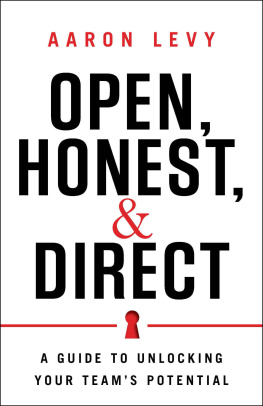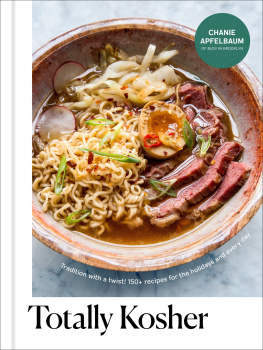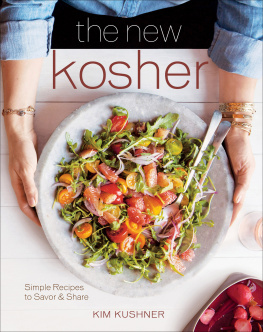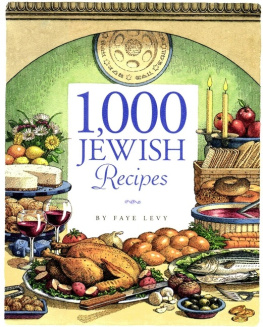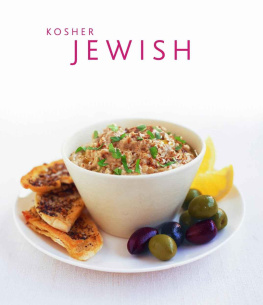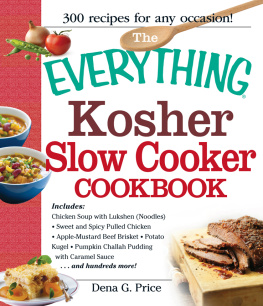First I wish to express my deep gratitude to my mother, Pauline Kahn Luria, whose spirit pervades this book. I owe my background in Jewish cooking most of all to her. She taught me Ashkenazi cooking and kashrut, as well as the importance of health conscious cooking and of exercise. And she passed on to me her joy in celebrating Shabbat and all the Jewish holidays with traditional foods.
I feel so lucky to have received ideas and cooking tips from chefs, caterers, friends, relatives, students of my cooking classes, and even shoppers I met at markets, who eagerly told me how they prepare their favorite dishes.
I owe much of my knowledge of fine cuisine to master chef Fernand Chambrette and pastry chef Albert Jorant, and to the many other teachers at cole de Cuisine La Varenne in Paris. What they taught me was the key to understanding how cooking works, and made it possible for me to follow such cooks directions as add a bit of this or add water until the dough feels good. I am grateful to Anne Willan, founder of the Parisian cooking school, and to prominent Israeli cookbook author Ruth Sirkis, for enabling me to spend fascinating years working on their wonderful cookbooks.
My mother-in-law, Rachel Levy, taught me a most important culinary lessonthe value of spices, as well as how to prepare delicious Yemenite Jewish specialties. I also learned a lot about IsraeliMiddle Eastern food, traditional and contemporary, from my sisters-in-law Hedva Cohen, Ety Levy, Nirit Levy, and Mati Kahn, and from my husbands Moroccan cousin Dvora Cohen.
My cousin Mildred Greenberg, Jewish cook par excellence, is full of good ideas for ways to prepare holiday foods that are tasty, healthy, and easy to fix. She always encourages me with her enthusiastic support, as did my dear aunt Sylvia Saks.
I have learned many wonderful Moroccan-Israeli dishes from my friends Valerie and Hayim Alon, who make Shabbat into a feast that is not only delicious but healthy, too. My creative friend Aviva Maoz also gave me many good ideas, as did her sister Ofra Alon, and their Iraqi-born mother, Karmela Arad. My friend, cookbook author Ronnie Venezia, and her mother, Lebanese-born Suzanne Elmaleh, taught me much about Lebanese Jewish cooking. I also gained a lot of information about Israeli cooking from my friend Lior Moore of Givatayim, who founded and runs cuisinemiddleast.com.
Good friends also taught me so much about ethnic foods and ingredients from around the world, which help to enliven healthy cooking. I learned about Asian foods from my dear friends Thai chef Somchit Singchalee, authors Nina Simonds and Linda Burum, about Turkish cuisine from Filiz Hosukoglu of Gaziantep, Turkey, and about Mexican foods from Leticia Ortega.
My friend, chef, and cookbook author Akasha Richmond has always been generous with her many inventive ideas for healthful cooking. I learned a lot about vegetarian cooking from my friends Nancy Eisman of Melissas Worldwide Produce and cookbook author Dana Jacobi.
I gained ideas for creative kosher cooking from Nili Goldstein, the owner of Magic Carpet, a Los Angeles Yemenite-Israeli restaurant; from chef and kosher caterer Nir Weinblut of Los Angeles; from Nilu Saadian, who gave me information about Persian-Jewish cooking; and from Guta Ben Simhon, chef-owner of La Guta restaurant in Jerusalem.
I thank Dr. Steven G. Pratt, author of Superfoods, for answering my nutrition questions. Robert Schueller of Melissas Worldwide Produce has always found the answers to my numerous queries about fruits and vegetables.
I appreciate the encouragement of my editors, Kim Upton at Tribune Media Services (formerly called the Los Angeles Times Syndicate) and Amanda Borschel-Dan, Atira Winchester, and Liat Collins of the Jerusalem Post .
I am so grateful to my agent, Jane Dystel, for her invaluable support. I wish to thank my editor at HarperCollins, Gail Winston, for making the process of producing the book so pleasant. I also appreciate the contributions of assistant editor Sarah Whitman-Salkin, copy editor Sonia Greenbaum, and production editor Ann Cahn.
Most of all, I appreciate the contribution of my virtual co-authormy husband, Yakir Levy, who helped me with every stage of preparing the book and made it such a pleasure to produce, from planning the book to interviewing people about their cooking, to revising what I wrote, and for always being happy to taste, to research, to learn, and to discover new ingredients and dishes.
This is a glorious time to be cooking healthy, kosher food. Modern Jewish cuisine has been enhanced and enlivened with the convergence in Israel of healthy traditions of both the Ashkenazi (Eastern and Central European) and Sephardi (Mediterranean and Middle Eastern) cooking styles.
Due to the cultural impact of the state of Israel on Jewish cooking everywhere, and thanks to the influx of Israeli immigrants to the United States, many Americans have become more familiar with Sephardi cuisine. This style of eating is essentially the Mediterranean diet, a popular model in America for healthy living.
Never before has such a wonderful array of foods been available for the Jewish home, both for holidays and everyday meals. Today, kosher ingredients are everywherenot just in Jewish markets. In mainstream supermarkets, kosher foods are easy to find and ethnic markets offer a variety of interesting specialties. I have used kosher-certified foods from Turkey, Italy, and France. A variety of kosher flatbreads is available, both Middle Eastern and Mexican; new kinds of lavash and many of the innovative tortillas made in interesting flavors and in whole-grain versions are kosher.
For cooks who wish to prepare healthy dinners with a creative touch, its exciting to discover the excellent selection of kosher foods in many gourmet markets and markets featuring natural, organic foods. Indeed, in many cases, these three types of foodsnatural, gourmet, and kosherhave merged. Many professional chefs praise the flavor of kosher poultry, which gets high marks in taste comparisons in food magazines. Delicious cheeses free of animal rennet are enjoyed by kosher and vegetarian cooks, and can also be found in many Middle Eastern markets. Faux meats such as soy pepperoni make possible a great range of dishes that previously could not be prepared by kosher cooks, and often are healthier than the original. Nutritious soy ice cream is a perfect pareve ending for a Shabbat roast chicken dinner.
All of these tasty choices are great news for kosher cooks. Having access to so many more healthy ingredients than before makes it easy to prepare wholesome versions of tried-and-true favorites and to branch out in new culinary directions.
Ashkenazi Jewish food has a reputation with some for being laden with high-fat meat and dairy products, but this is often due to their impressions from eating at delis eager to promote their reputations as home of the overstuffed sandwich. Those deli menus were originally designed for special occasions and were developed when immigrants were enthralled by the plentiful rich food of the United States; this is not typical home cooking. I grew up in an Orthodox Ashkenazi home and our meals often consisted of fish as an entre, without a great deal of meat or high-fat dairy.






